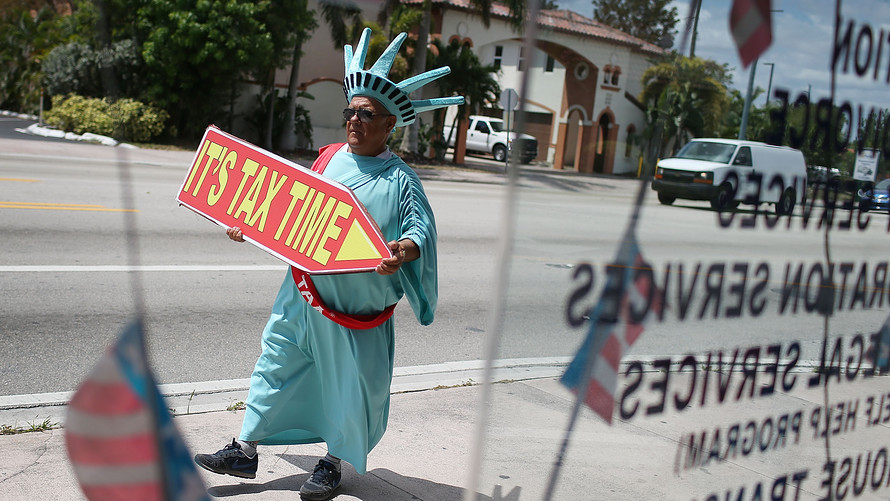
Tax-filing season started this week — and some taxpayers might be in for an unpleasant surprise.
Some 21% of taxpayers could be “underwithheld” this year, meaning their employer didn’t take enough money out of their paychecks to cover their tax obligations, according to the Government Accountability Office. The report, which was based on a Treasury Department simulation, found the Tax Cuts and Jobs Act of 2017 accounted for 3 million more taxpayers now owing the Internal Revenue Service. If tax laws had remained unchanged, 18% of taxpayers would have been underwithheld, the analysis showed.
Some 21% of taxpayers could be underwithheld this year, meaning their employer didn’t take enough money out of their paychecks to cover their tax obligations.
The Tax Cuts and Jobs Act was considered the biggest tax-law change in more than three decades. Those at risk of falling short on their tax obligations include taxpayers who claimed personal and dependent exemption deductions under the old tax law but won’t under the TCJA, gamblers on a winning streak, others with unreimbursed employment-related expenses, and people who can’t claim full state and local taxes as itemized deductions.
About 90% of wage earners saw their paychecks get bigger last year, said Christina Taylor, senior manager of tax operations at Credit Karma, a personal-finance company that provides free credit scores and credit reports for consumers. Many people likely didn’t realize that could mean a lower refund and, as such, may not have made the required changes, Taylor said.
The IRS usually fines taxpayers who owe more than 10% of their tax debt when filing their returns, but the government agency is adjusting its policy because of major tax reform, which is being implemented in tax returns for the first tax season this year. Taxpayers who have paid at least 85% of their tax liability are eligible for the one-time waiver.
Still, not all Americans can afford the debt they’ll come upon this season.
Here are four things they should do:
Don’t delay filing
Taxpayers should still file their returns by the April 15 deadline, and pay as much as they can to avoid penalties and interest. Extending the deadline to file a return does not also extend the deadline to pay a tax bill.
The penalty for filing late is 5% of the unpaid taxes each month, up to a maximum of 25%, and begins accruing the day after the deadline.
The penalty for filing late is 5% of the unpaid taxes each month, up to a maximum of 25%, and begins accruing the day after the deadline. The penalty for not paying your taxes by the deadline is one-half of 1% of unpaid taxes, and also begins accruing the day after the deadline. If both the failure-to-file and failure-to-pay penalties apply in a month, the maximum penalty for both is 5%.
These penalties may be waived if there is a reasonable cause for not filing or paying on time, according to the IRS. A reasonable cause includes a fire or natural disaster that affected you, or death or an illness of the taxpayer or a member of the immediate family.
Work with the IRS
The IRS has two avenues for those who can’t pay off their tax bill by Tax Day: an “offer in compromise” or an installment payment plan.
With an ‘offer in compromise,’ taxpayers don’t have to pay their entire tax liability if they meet requirements based on income, expenses and equitable assets.
With an “offer in compromise,” taxpayers do not have to pay their entire tax liability if they meet certain requirements based on their income, expenses and equitable assets. Those looking to apply must be up-to-date with their tax returns and previous tax payments, and not be in an open bankruptcy proceeding.
The IRS has a tool to determine pre-qualification, which asks for household information, bank balances, home and vehicle values, any income sources and typical monthly expenses for rent, public transportation and health insurance.
Those who owe more than they can afford can also set up one of three payment plans. With all options, payment includes the debt owed, as well as accrued penalties and interest until the balance is paid in full:
• A short-term payment plan of 120 days or less: There is no setup fee.
• Long-term payment plan with automatic withdrawals: There is a $31 setup fee for online applications and a $107 setup fee if done over the phone, mail or in-person (low-income earners’ fee is waived).
• Long-term payment plan without automatic withdrawals: The online application fee is $149, and $43 for low-income earners, which may be reimbursed under certain conditions). The set-up fee for applications by phone, mail or in-person is$225. These payments can be done with debit or credit cards, check or money order.
Take a loan
Taxpayers who want to pay their debts immediately may have to rely on alternative income sources, like family or friends, a retirement account or credit card. They should be cautious with any of these options, however.
Loans from your own 401(k) plan use low interest rates, said David Silversmith, a financial planner and certified public accountant in New York City. “You can then pay back the loan a little at a time,” he said. “This is a much better solution than the payday lenders because those interest rates are incredibly high.” Loans must be repaid within five years.
There are risks associated with 401(k) loans, including stopping contributions in lieu of loan repayments — which would essentially reduce your future retirement balance — or owing penalties and taxes if that employee leaves the job before the loan is paid in full.
The IRS can accept credit-card payments via third-party companies, but those typically come with a fee. Taxpayers should only use this option if their cards offer zero-interest rates and they can pay off that debt quickly, Taylor said. Certain cards, including the American Express EveryDay Preferred AXP, +0.03% and the Discover it Miles DFS, -0.34% have rewards that could be worth more than the processing fees consumers will pay for charging their tax obligations.
For some people who are desperate to pay their taxes, payday lenders may seem like a quick solution to a cash-flow shortage, but interest rates can be as high as 400%. Tax-preparation companies might also see more demand for refund-advance loans, especially given the partial government shutdown in January that threatened to delay refunds. The Trump administration has assured Americans refunds will be delivered with the same time window as usual.
Fix it for next year
When the federal-tax withholdings tables came out in February 2018, a majority of employees saw an increase in their paychecks. Tax tables determine how much employers withhold from a paycheck, but workers have some say when they choose how many allowances to claim. The higher the number of allowances, the less money is withheld — that means a bigger paycheck, but also increases the risk that you may owe more than you expect come Tax Day.
Taxpayers who expect to owe more than they anticipated this year may want to adjust their withholdings now to avoid the same issue in 2020, and can do so through the W-4 forms employers provide. The IRS also suggests making quarterly estimated tax payments instead of annual returns to avoid owing taxes this season.
























